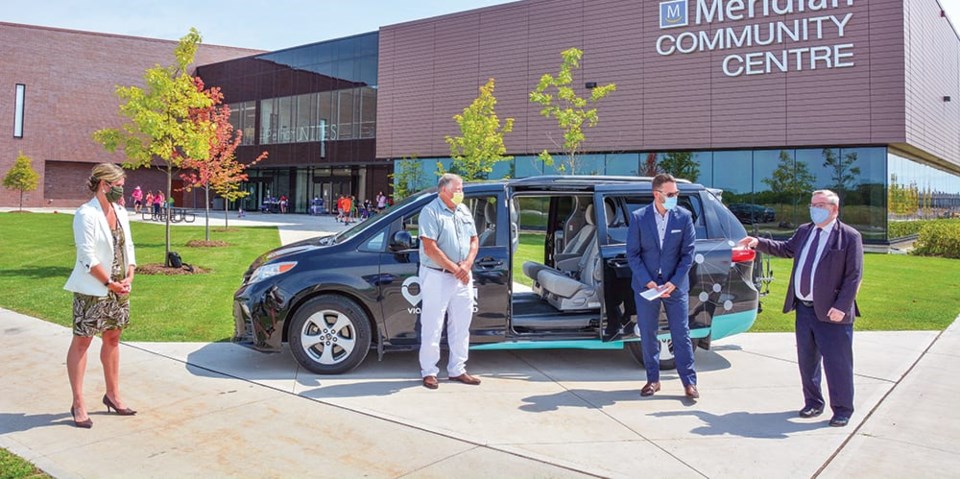New Regional services would augment NRT OnDemand in Pelham
The Linking Niagara Transit Team has spent 11 years, in conjunction with the Region and its 12 municipalities, creating a framework for a single, consolidated transit system for all of Niagara. The proposed model would bring consistent operating hours and fares, new digital payment technology, and better connections for riders.
In the final phase of refinement, public feedback is being solicited. Niagara residents can share their views on the future of regional transit by completing an online survey at www.MovingTransitForward.ca.
A decision on implementation of the program could be made as early as this fall. Triple majority approval is required, based on support by Regional Council, local municipal councils, and a majority of Niagara’s population. A three-phase strategy would guide the evolution of the system over a five-year period, funded by Niagara Region’s budget through 12 municipal special levies, to ensure that residents and transit users only pay for the services that they directly receive.
A Zoom broadcast providing an overview of the consolidated transit plan occurred last week, hosted by Communications Consultant Andrew Korchok, of the Strategic Communications and Public Affairs Office at Niagara Region. The panel of presenters included St. Catharines City Councillor and Chair of the Linking Niagara Transit Committee, Mat Siscoe, Regional Councillor for Grimsby and Committee Vice-Chair Wayne Fertich, Lincoln CAO Mike Kirkopoulo, Port Colborne CAO Scott Luey, and Matt Robinson from the GO Implementation Office.
The presenters highlighted that one integrated transit system would be scalable to meet the needs of a growing population, create better access to jobs and services in Niagara, and open up new employment options for residents in neighbouring municipalities, via its connectivity with GO Transit service. The system would also be eco-friendly, providing a more sustainable option by reducing traffic congestion and greenhouse gas emissions.
Siscoe provided an overview of the different services currently in operation in Niagara, which include three conventional transit systems (in St. Catharines, Niagara Falls, and Welland), Niagara Regional Transit, Niagara Specialized Transit, and NRT-OnDemand (essentially a ride-sharing program focused on smaller municipalities, which has proven to be popular in Pelham.)
The $46.4 million operating budget and first year capital replacement strategy of $2.2 million for the integrated transit system may be initially off-putting for some local politicians, but Siscoe said that the system could prove to be close to revenue-neutral for some municipalities, given their current transit operations.
“Municipalities will be able to dictate, to a certain extent, how much additional service than they want and how much they're willing to pay for,” he said.
“It's very problematic right now for somebody in a smaller municipality to connect into the main network,” said Siscoe, “but under the single integrated transit system, with consistent operating hours, fewer stops, and more explicit rates, there will be less friction for residents, which will lead to more people taking the bus and considering it a very viable option when they need to go places.”
Siscoe said that his committee had “spent a lot of time on collaboration over the last several months, speaking to municipalities, bringing their feedback and really narrowing the focus to ensure that we're meeting their concerns.”
As to governance, Kirkopoulo said that all local municipalities would have a voice on a newly formed Niagara Transit Commission, with additional expertise available through a 20-member community advisory panel.
Furtick noted that with the rapid population growth in Grimsby and Lincoln, “we definitely need to have transit to be competitive and provide service to the GTA, as well as within Niagara Region. The influx of residents from the GTA is astronomical.”
He also foresaw a positive impact of integrated transit on Brock University and Niagara College enrollments, allowing students from throughout the region, as well as Hamilton and Halton, to easily access the campuses.
Luey offered some philosophical insight into the financial implications.
“I think when we look at our tax bill, we're paying for a lot of services that sometimes don't impact us directly. You might not be a library user, but some of your property tax bill goes to the library. You might not have children who go to the arena. But having healthy kids and recreation programs for kids is a good community initiative. And I look at this as a community initiative for all of Niagara. We're probably 20 or 30 years behind some other jurisdictions that have regional transit. This is a social and economic development initiative, and it can be a healthcare initiative for folks who need to get to medical appointments in a different community.”
Ask for comment by the Voice on the integrated transit initiative from Pelham’s perspective, CAO David Cribbs said that “since Pelham has no hospital or post-secondary institutions, and given that those are always the major points of service for transit systems, this is an opportunity that must be given serious consideration. That being said, there remain challenges and difficulties with the system as envisioned—cost being a factor— of which council is aware, and has attempted to address through requesting changes and enhancements to the plans.”
Almost three years into council’s mandate, Cribbs said, “this may be the most significant decision faced to date.”



